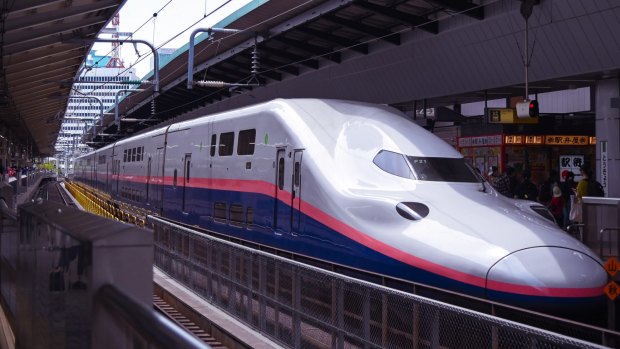This was published 1 year ago
Trains versus planes: A new golden age of rail travel is upon us
By Ute Junker

Japan is home to one of the world's best rail networks.Credit: Steenium
The pharaohs did it in royal barges. For modern travellers wanting to visit Egypt's most spectacular temples and tombs, arrangements tend to be slightly more complicated. Most will take a flight from Cairo to Luxor, where they explore the highlights of ancient Memphis and the Valley of the Kings before drifting down the river on a Nile cruiser all the way to Aswan and the splendour of Abu Simbel.
Soon, however, all travellers may need is a train ticket. Plans for Egypt's first high-speed railway have been announced, with German firm Siemens Mobility to build a 1000 kilometre line between Cairo and Aswan, along with routes connecting the Red Sea and the Mediterranean coast. The fully-electrified trains will have a top speed of 230km/h, making Egypt's ancient sites more accessible than ever before.
This is the new and golden age of rail. After decades in which flying became ever-cheaper and more popular, the pendulum is swinging back. Driven by the need to combat the climate crisis, countries around the world are investing heavily in rail, creating exciting new travel options for passengers.
In Europe, sleeper trains are experiencing a renaissance, with new routes including the Nightjet Zurich connecting the Swiss city with Amsterdam, and European Sleeper's train from Brussels to Prague via Amsterdam and Berlin.
New high-speed rail lines are also being rolled out across the Continent, including the ambitious Rail Baltica project. Scheduled to open in 2026, the electric line will run from Finland via Estonia, Latvia and Lithuania all the way to Poland. The Helsinki-Tallin leg will initially be operated by ferries until a planned undersea tunnel is completed.
The European Union wants to see high-speed lines double by 2030 and triple by 2050, and has provided €5.4 billion euros ($7.2 billion) to 135 transport infrastructure projects across the Continent. Although several European countries have already invested in high-speed lines – think Madrid to Barcelona, Rome to Milan, Berlin to Munich – the goal is to create high-speed routes that will link the entire Continent.
It is a big ask. To reach the 2030 target, the existing high-speed network will need to increase by 75 per cent. The environmental benefits could be equally impressive. Seventeen of the Continent's 20 busiest air routes cover 700 kilometres or less, making them suitable to be replaced by high-speed rail.
With countries as diverse as Croatia and the Czech Republic investing in tracks and trains, the Community of European Railways is working on creating a single ticketing platform by 2025 to make booking as effortless as the travel experience.
Europe isn't the only region investing heavily in rail. China, already home to the world's largest high-speed network, plans to extend its lines by a third by 2025, to a total of 50,000 kilometres. It has also been constructing high-speed rail lines across Asia and beyond, including a line from Bangkok to Laos set to open in 2028 which will connect with an existing Laos-China line.
In Japan, home of one of the world's best rail networks, Tokyu Railways has become the first operator to power all of its lines using renewable energy: solar, geothermal and hydropower. According to the company, this reduces the carbon emissions of an average journey to just 180g. Rival operator Tobu Railway is launching a new fleet of trains next year which will reduce its carbon emissions by up to 40 per cent.
Japan has also announced plans for its first mag-lev train, to run between Tokyo and Nagoya starting in 2037. With a maximum speed of 500km/h it will cut the current travel time in half, covering the stretch from Tokyo to Osaka to about an hour.
France also recently unveiled its fourth-generation high-speed trains, dubbed TGV M, which will be in service in time for the 2024 Paris Olympics. They use 20 per cent less energy and reduce carbon emissions by 32 per cent.
Even more ambitious is the Polish Nevomo network, predicted to cut travel time between Krakow and Gdansk from six hours to just 35 minutes. The company claims that its MagRail technology, currently in the testing phase, will reach speeds of up to 550km/h operating on existing rail lines, abolishing the need for expensive railway upgrades.
Sign up for the Traveller Deals newsletter
Get exclusive travel deals delivered straight to your inbox. Sign up now.